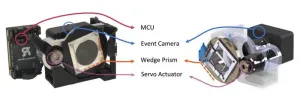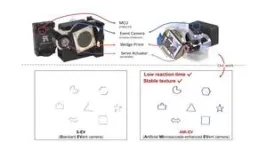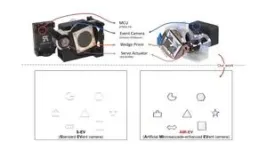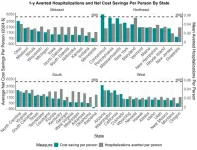(Press-News.org) A team led by University of Maryland computer scientists invented a camera mechanism that improves how robots see and react to the world around them. Inspired by how the human eye works, their innovative camera system mimics the tiny involuntary movements used by the eye to maintain clear and stable vision over time. The team’s prototyping and testing of the camera—called the Artificial Microsaccade-Enhanced Event Camera (AMI-EV)—was detailed in a paper published in the journal Science Robotics in May 2024.
“Event cameras are a relatively new technology better at tracking moving objects than traditional cameras, but -today’s event cameras struggle to capture sharp, blur-free images when there’s a lot of motion involved,” said the paper’s lead author Botao He, a computer science Ph.D. student at UMD. “It’s a big problem because robots and many other technologies—such as self-driving cars—rely on accurate and timely images to react correctly to a changing environment. So, we asked ourselves: How do humans and animals make sure their vision stays focused on a moving object?”
For He’s team, the answer was microsaccades, small and quick eye movements that involuntarily occur when a person tries to focus their view. Through these minute yet continuous movements, the human eye can keep focus on an object and its visual textures—such as color, depth and shadowing—accurately over time.
“We figured that just like how our eyes need those tiny movements to stay focused, a camera could use a similar principle to capture clear and accurate images without motion-caused blurring,” He said.
The team successfully replicated microsaccades by inserting a rotating prism inside the AMI-EV to redirect light beams captured by the lens. The continuous rotational movement of the prism simulated the movements naturally occurring within a human eye, allowing the camera to stabilize the textures of a recorded object just as a human would. The team then developed software to compensate for the prism’s movement within the AMI-EV to consolidate stable images from the shifting lights.
Study co-author Yiannis Aloimonos, a professor of computer science at UMD, views the team’s invention as a big step forward in the realm of robotic vision.
“Our eyes take pictures of the world around us and those pictures are sent to our brain, where the images are analyzed. Perception happens through that process and that’s how we understand the world,” explained Aloimonos, who is also director of the Computer Vision Laboratory at the University of Maryland Institute for Advanced Computer Studies (UMIACS). “When you’re working with robots, replace the eyes with a camera and the brain with a computer. Better cameras mean better perception and reactions for robots.”
The researchers also believe that their innovation could have significant implications beyond robotics and national defense. Scientists working in industries that rely on accurate image capture and shape detection are constantly looking for ways to improve their cameras—and AMI-EV could be the key solution to many of the problems they face.
“With their unique features, event sensors and AMI-EV are poised to take center stage in the realm of smart wearables,” said research scientist Cornelia Fermüller, senior author of the paper. “They have distinct advantages over classical cameras—such as superior performance in extreme lighting conditions, low latency and low power consumption. These features are ideal for virtual reality applications, for example, where a seamless experience and the rapid computations of head and body movements are necessary.”
In early testing, AMI-EV was able to capture and display movement accurately in a variety of contexts, including human pulse detection and rapidly moving shape identification. The researchers also found that AMI-EV could capture motion in tens of thousands of frames per second, outperforming most typically available commercial cameras, which capture 30 to 1000 frames per second on average. This smoother and more realistic depiction of motion could prove to be pivotal in anything from creating more immersive augmented reality experiences and better security monitoring to improving how astronomers capture images in space.
“Our novel camera system can solve many specific problems, like helping a self-driving car figure out what on the road is a human and what isn’t,” Aloimonos said. “As a result, it has many applications that much of the general public already interacts with, like autonomous driving systems or even smartphone cameras. We believe that our novel camera system is paving the way for more advanced and capable systems to come.”
###
In addition to He, Aloimonos and Fermüller, other UMD co-authors include Jingxi Chen (B.S. ’20, computer science; M.S. ’22, computer science) and Chahat Deep Singh (M.E. ’18, robotics; Ph.D. ’23, computer science).
This research is supported by the U.S. National Science Foundation (Award No. 2020624) and National Natural Science Foundation of China (Grant Nos. 62322314 and 62088101). This article does not necessarily reflect the views of these organizations.
The paper, “Microsaccade-inspired event camera for robotics,” was published in Science Robotics on May 29, 2024.
END
UNIVERSITY PARK, Pa. — To advance soft robotics, skin-integrated electronics and biomedical devices, researchers at Penn State have developed a 3D-printed material that is soft and stretchable — traits needed for matching the properties of tissues and organs — and that self-assembles. Their approach employs a process that eliminates many drawbacks of previous fabrication methods, such as less conductivity or device failure, the team said.
They published their results in Advanced Materials.
“People have been developing soft and stretchable conductors for almost a decade, but the conductivity ...
Waltham — July 1, 2024 — For patients with severe obesity undergoing knee or hip replacement, commonly obtained laboratory values – including markers of anemia and inflammation – are independent predictors of the risk of periprosthetic joint infection (PJI), reports a study in The Journal of Bone & Joint Surgery. The journal is published in the Lippincott portfolio by Wolters Kluwer.
Hemoglobin level, platelet count, and several markers of systemic inflammation may be relevant to the elevated ...
Chicago (July 1, 2024) — According to new research looking at every U.S. state, programs that deliver medically tailored meals (MTMs) to people with diet-sensitive conditions such as diabetes and heart disease along with limitations in the ability to perform daily activities could lead to substantial savings in healthcare costs. Using computer models to estimate the benefits of such programs minus the expense of implementing them, researchers found significant variation between U.S. states but an overall net cost savings in almost every state.
“By ...
When power plants burn fossil fuels at high temperatures, nitrogen and oxygen molecules break apart and then recombine to form a class of compounds called nitrogen oxides, or NOx. These gasses are major pollutants and contribute to—among other things—acid rain and global warming.
One way to curb such emissions is with a catalytic converter, similar to what’s used in a vehicle.
“The catalytic converter injects ammonia into the plant’s emissions stream, and the hydrogen in the ammonia reacts with the oxygen in the NOx, and the products ...
About The Study: In this phase 2 prospective validating paired cohort study, fluorine-18 PSMA-1007 PET/computed tomography was superior to magnetic resonance imaging (MRI) for the locoregional staging of prostate cancer. These findings support PSMA PET in the preoperative workflow of intermediate-risk and high-risk tumors.
Corresponding Author: To contact the corresponding author, Adam Kinnaird, M.D., Ph.D., email ask@ualberta.ca.
To access the embargoed study: Visit our For The Media website at ...
Hong Xue, Associate Professor, Health Administration and Policy, received funding for the project: “Innovating and Implementing Youth Tobacco Prevention in Virginia.”
Xue will leverage the forefront of technological innovation, utilizing generative artificial intelligence (AI) and state-of-the-art immersive technologies, integrating them with novel just-in-time adaptive intervention strategies, to tackle the pressing public health issue of electronic cigarette/tobacco use among the youth in Virginia.
Xue will receive $450,000 from Virginia ...
Emanuel Petricoin, Co-Director, Center for Applied Proteomics and Molecular Medicine (CAPMM), received funding for the project: “Protein Pathway Activation Based Signaling Mapping of Head And Neck Cancers.”
CAPMM researchers will receive laser microdissected tumor samples from banked Formalin-Fixed Paraffin-Embedded (FFPE) clinical biopsy samples from patients with HPV‐positive head and neck cancers who were treated for newly diagnosed disease.
The researchers will utilize comprehensive reverse‐phase ...
Emanuela Marasco, Assistant Professor, Center for Secure Information Systems, received funding for the project: “Identity Verification in Smartphones as Social Intersectionality: Inclusive Design of Contactless Fingerprints to Mitigate Skin Tone and Gender Bias.”
She is developing a contactless biometric mobile security application that can mitigate the vulnerabilities of deep artificial intelligence and optical sensors and allow marginalized identities the same access to data security.
As part of their work, members of the project team will identify the impact of physical vulnerabilities; their ...
Cancer treatments often cause nerve damage that can lead to long-lasting symptoms. Medication has proven ineffective in these cases. A sports scientist at the University of Basel, together with an interdisciplinary team from Germany, has now shown that simple exercises can prevent nerve damage.
Cancer therapies have improved over the years. It is no longer just about sheer survival: quality of life after recovery is gaining more importance.
Unfortunately, many cancer medications, from chemotherapy to modern immunotherapies, attack the nerves as well as the tumor cells. Some therapies, such as oxaliplatin or vinca alkaloids, leave 70 to 90 percent of patients complaining of pain, balance ...
New UCSF study shows that suppressing a protein turns ordinary fat into a calorie burner and may explain why drug trials attempting the feat haven’t been successful.
Researchers at UC San Francisco have figured out how to turn ordinary white fat cells, which store calories, into beige fat cells that burn calories to maintain body temperature.
The discovery could open the door to developing a new class of weight-loss drugs and may explain why clinical trials of related therapies have ...






